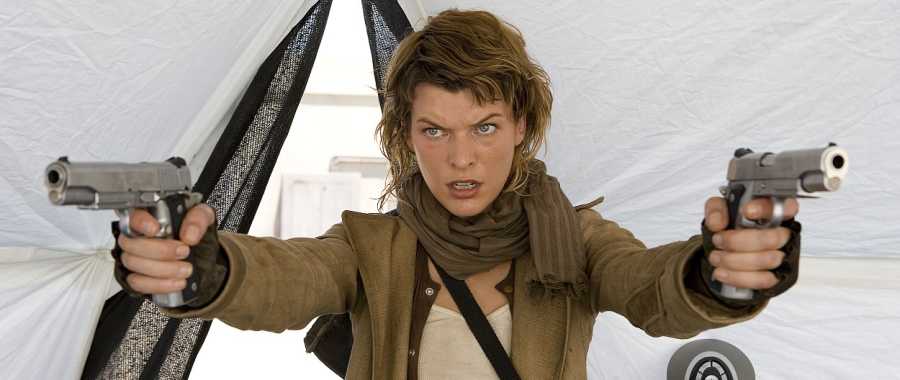 ★★★
★★★
“Extinction event.”
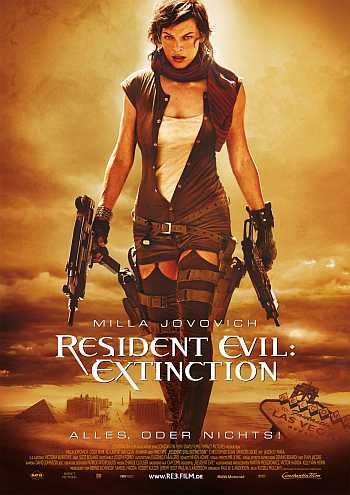 Has it really been three years since the last installment? Guess so. Therefore, about time for the most durable of the video-game to movie franchises, to pop up with another entry. Things continue to go from bad to worse as far as Planet Earth is concerned, with the T-virus, which spread from the complex to Raccoon City last time, now infecting the entire world. A few survivors roam the wastelands, such as in a convoy led by Claire Redfield (Larter), unable to stay in one place too long, because the zombies will locate them. Meanwhile, Dr. Isaacs (Glen) is working on reversing the virus, or at least making the zombies docile – though his approach to scientific teamwork leaves a little to be desired, shall we say. He also has a pit where he disposes of his raw material, an aspect that reminded me of the original Aeon Flux short films.
Has it really been three years since the last installment? Guess so. Therefore, about time for the most durable of the video-game to movie franchises, to pop up with another entry. Things continue to go from bad to worse as far as Planet Earth is concerned, with the T-virus, which spread from the complex to Raccoon City last time, now infecting the entire world. A few survivors roam the wastelands, such as in a convoy led by Claire Redfield (Larter), unable to stay in one place too long, because the zombies will locate them. Meanwhile, Dr. Isaacs (Glen) is working on reversing the virus, or at least making the zombies docile – though his approach to scientific teamwork leaves a little to be desired, shall we say. He also has a pit where he disposes of his raw material, an aspect that reminded me of the original Aeon Flux short films.
Into this comes Alice (Jovovich), who vanished off the grid, when she realised the Umbrella Corporation were tracking her. She gets lured in by a fake distress call, but after disposing of some zombie dobermans, eventually joins Redfield’s crew, just in time to save them from an attack by zombie crows [Mulcahy clearly having been inspired by The Birds, though I can’t help wondering how they got the cool contact lenses into the avian predators’ eyes.] They hear rumours of sanctuary in Alaska, and decide to head there – that requires a refuelling stop in what’s left of Vegas. However, Umbrella have been alerted by Alice’s burgeoning psychic powers and have left a nasty surprise…
S’ok. Mulcahy is no stranger to franchise cinema, having done the first couple of Highlander films, and the harsh desert lighting and exterior landscape is a nice contrast to the usual, dark, claustrophobic approach adopted by most Z-flicks. His experience is of particular use in the action sequences, where he does a better job of avoiding the cinematic excesses, in which Alexander Witt indulged, too frequently, last time up. The script is merely workmanlike: it feels too much like a series of cool set-pieces joined in the editing bay, rather than springing organically from the storyline.
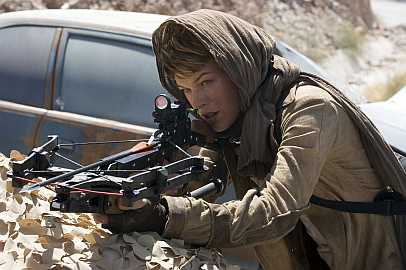 The main problem, I feel, is that giving Alice mental powers detracts from the physical side of action, which has always been a major part of this series’s appeal: watching Jovovich kick zombie butt. The Las Vegas battle is unquestionably the highlight of the film as far as that goes, with Alice adopting a no-nonsense, slice-and-dice approach, that’s a gleeful joy to watch. After it, however, things go somewhat wonky: the entire Redfield subplot is airily waved away, and then there’s the inevitable boss level fight – this time against the Tyrant [if you’ve played the games, you probably know what that is, which puts you one-up on me], a somewhat rubbery, tenticular beast that is not among Patrick Tatopoulos’s best work.
The main problem, I feel, is that giving Alice mental powers detracts from the physical side of action, which has always been a major part of this series’s appeal: watching Jovovich kick zombie butt. The Las Vegas battle is unquestionably the highlight of the film as far as that goes, with Alice adopting a no-nonsense, slice-and-dice approach, that’s a gleeful joy to watch. After it, however, things go somewhat wonky: the entire Redfield subplot is airily waved away, and then there’s the inevitable boss level fight – this time against the Tyrant [if you’ve played the games, you probably know what that is, which puts you one-up on me], a somewhat rubbery, tenticular beast that is not among Patrick Tatopoulos’s best work.
Compared to the fight against the Nemesis in Apocalypse, this is a major disappointment, largely consisting of them hurling psionic shock-waves at each other. I’m sorry. This isn’t the Resident Evil I signed up for. I signed up for the one with the knock-down, drag-out punchfests, not the Harry Potter-esque BS. There’s a nice sense of symmetry, in that the battle ends in the corridor with the laser protection system, but the mechanism with which it ends is disappointing, rather than having Alice beat the Tyrant. Certainly, the lamest climactic battle of the three films.
 Things do perk up at the very end. As in the first two films, there’s a grand final shot, which leaves you eagerly anticipating the next part – in this case, presumably called Resident Evil: Globapocarnarmagediediedie. Certainly, I wouldn’t be averse to seeing a fourth installment, though I would be inclined to send the makers a stiff memo before they begin production. Item #1. Try and come up with some ideas of your own. As well as the above-mentioned Hitchcock thievery, the film also borrows wholesale from Day of the Dead, Mad Max 2 and Mad Max 3, plus Alien: Resurrection. #2. After the apocalypse, the survivors will have plenty of Sony products with which to work. Really. Ease off on the unsubtle product-placement.
Things do perk up at the very end. As in the first two films, there’s a grand final shot, which leaves you eagerly anticipating the next part – in this case, presumably called Resident Evil: Globapocarnarmagediediedie. Certainly, I wouldn’t be averse to seeing a fourth installment, though I would be inclined to send the makers a stiff memo before they begin production. Item #1. Try and come up with some ideas of your own. As well as the above-mentioned Hitchcock thievery, the film also borrows wholesale from Day of the Dead, Mad Max 2 and Mad Max 3, plus Alien: Resurrection. #2. After the apocalypse, the survivors will have plenty of Sony products with which to work. Really. Ease off on the unsubtle product-placement.
#3. Where was Jill Valentine? Okay, we’re kind of fond of Oded Fehr (he’s very good in Sleeper Cell), who does return as Carlos Olivera. And Larter, whom you’ll recognise from the first couple of Final Destination films, isn’t bad in her role, with a couple of kick-ass moments (left); there’s a possibility RE4 may concentrate on her. However, Sienna Guillory was better than either of them, and her unexplained absence this time is disappointing. Guess she asked for too much money or something. Finally, and most importantly, #4: skip the mental telepathy nonsense, no matter how much Milla Jovovich may want to wrinkle her forehead and lob psychic blasts at things. Just make her kick ass. The ending does give plenty of scope for development: without giving too much away, Alice could become the Swiss Army Knife of dispatching undead, with a variety of useful options. Overall, while some way short of perfect, this isn’t bad – and after some serious disappointments in recent years, it’s just good to see an action heroine back at the top of the box-office.
Dir: Russell Mulcahy
Star: Milla Jovovich, Iain Glen, Ali Larter, Oded Fehr
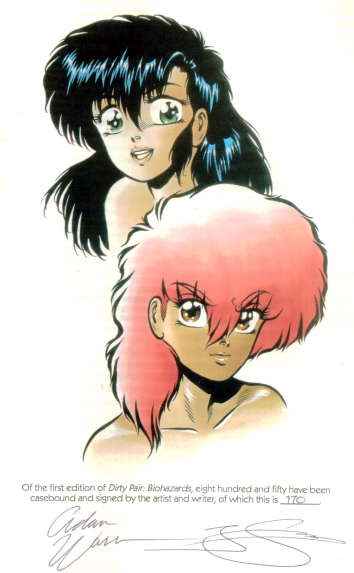 If you thought the novel was a quick read, I got through Biohazards during lunch, and that’s only with 30 minutes. Still, being a comic-book, we must cut it some slack, though I can’t say I find action (and there’s a lot of it here) is something that works very well in panel form, lacking the true sense of motion you get in cinema. That said, I still didn’t hate this first entry in the trans-Pacific entry, in which Kei and Yuri are sent to investigate the kidnapping of an industrialist’s mind by his rival [literally: it’s on a chip]. Adding a little spice, both companies are knee-deep in dubious bioweapons, so who is the real villain here?
If you thought the novel was a quick read, I got through Biohazards during lunch, and that’s only with 30 minutes. Still, being a comic-book, we must cut it some slack, though I can’t say I find action (and there’s a lot of it here) is something that works very well in panel form, lacking the true sense of motion you get in cinema. That said, I still didn’t hate this first entry in the trans-Pacific entry, in which Kei and Yuri are sent to investigate the kidnapping of an industrialist’s mind by his rival [literally: it’s on a chip]. Adding a little spice, both companies are knee-deep in dubious bioweapons, so who is the real villain here?




 Coincidentally, a year after the first collection, I find the time to read volume two; this contains two stories rather than two-and-a-fragment, but weighs in at about forty pages or so longer. Same price though, I am pleased to note… The first, Legion, takes our FBI agent and her semi-vampiric colleagues off to the post-flood city of New Orleans where a demonic force has been unleashed, which is capable of transferring its presence from one body to another. Hmmm…sounds not unlike Fallen, perhaps? That aside, I did enjoy this one thoroughly: the pace is good and, if the eventual destination of the entity is not perhaps a surprise (it’s quite close to the pair, shall we say), it makes for some great set-pieces. The best of these involves a church where the possessed victim is resting up, which results in a hellacious battle that’s genuinely exciting. The story elements are tidied up nicely too, leaving this a self-contained and effective tale.
Coincidentally, a year after the first collection, I find the time to read volume two; this contains two stories rather than two-and-a-fragment, but weighs in at about forty pages or so longer. Same price though, I am pleased to note… The first, Legion, takes our FBI agent and her semi-vampiric colleagues off to the post-flood city of New Orleans where a demonic force has been unleashed, which is capable of transferring its presence from one body to another. Hmmm…sounds not unlike Fallen, perhaps? That aside, I did enjoy this one thoroughly: the pace is good and, if the eventual destination of the entity is not perhaps a surprise (it’s quite close to the pair, shall we say), it makes for some great set-pieces. The best of these involves a church where the possessed victim is resting up, which results in a hellacious battle that’s genuinely exciting. The story elements are tidied up nicely too, leaving this a self-contained and effective tale.
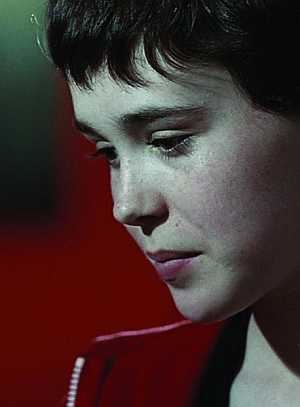 This is almost unbearably creepy, in two different directions: however, it’s almost impossible to discuss this film in any meaningful way without spoilers, so you have been warned. The danger of online predators is well-known, and when fourteen-year old Hayley (Page) agrees to meet photographer Jeff (Wilson), who is in his thirties, alarm bells are ringing. They reach a piercing level after she goes to his house, starts drinking vodka and flirting outrageously. However, the tables are abruptly turned: she’s spiked Jeff’s drink, and he wakes to find himself tied-up, and entirely at Hayley’s mercy. He soon finds out that’s a quality she is very definitely
This is almost unbearably creepy, in two different directions: however, it’s almost impossible to discuss this film in any meaningful way without spoilers, so you have been warned. The danger of online predators is well-known, and when fourteen-year old Hayley (Page) agrees to meet photographer Jeff (Wilson), who is in his thirties, alarm bells are ringing. They reach a piercing level after she goes to his house, starts drinking vodka and flirting outrageously. However, the tables are abruptly turned: she’s spiked Jeff’s drink, and he wakes to find himself tied-up, and entirely at Hayley’s mercy. He soon finds out that’s a quality she is very definitely 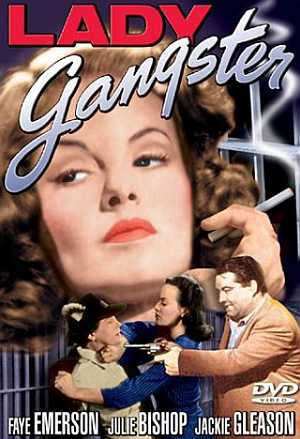 Having watched both Transformers and Miami Vice over the past week, it’s nice to see a film that doesn’t hang around: coming in at sixty-two minutes, Lady Gangster has hardly a line of dialogue that does not propel the story forward. Based on the play, Ladies They Talk About (previously a 1933 film starring Barbara Stanwyck), this centers on Dorothy Burton, member of a gang of bank-robbers. She takes the rap for one of their jobs, and goes to jail, but is also the only one who knows where the loot is hidden. Childhood friend Kenneth Phillips (Wilcox), now a renowned broadcaster, tries to help Dorothy get parole, but she has also made an enemy inside the prison, who is just as keen our heroine does not get released, and her former gang colleagues have their own interests, needless to say.
Having watched both Transformers and Miami Vice over the past week, it’s nice to see a film that doesn’t hang around: coming in at sixty-two minutes, Lady Gangster has hardly a line of dialogue that does not propel the story forward. Based on the play, Ladies They Talk About (previously a 1933 film starring Barbara Stanwyck), this centers on Dorothy Burton, member of a gang of bank-robbers. She takes the rap for one of their jobs, and goes to jail, but is also the only one who knows where the loot is hidden. Childhood friend Kenneth Phillips (Wilcox), now a renowned broadcaster, tries to help Dorothy get parole, but she has also made an enemy inside the prison, who is just as keen our heroine does not get released, and her former gang colleagues have their own interests, needless to say.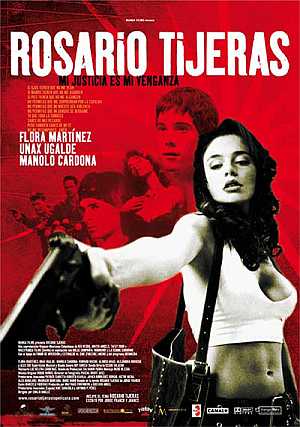 Antonio (Ugalde) and Emilio (Cardona) meet the gorgeous Rosario (Martinez) at a nightclub in Medellin, Columbia, and both form a relationship with her – Emilio, a physical one; Antonio, a platonic but perhaps more deeply felt attachment. While information on Rosario is limited, not least from herself, they soon discover that she has a dark past (Tijeras isn’t her surname, it’s Spanish for “scissors”. Let’s leave it at that, shall we?) and a dark present (among the many rumour swirling around is that she has killed 200 or more, in her role as a hitwoman for the local drug cartels). Nor is the forecast for her future sunshine and rainbows, since the first scene has Antonio carrying a badly shot-up Rosario into a local hospital, with the rest of the film told in a series of flashbacks.
Antonio (Ugalde) and Emilio (Cardona) meet the gorgeous Rosario (Martinez) at a nightclub in Medellin, Columbia, and both form a relationship with her – Emilio, a physical one; Antonio, a platonic but perhaps more deeply felt attachment. While information on Rosario is limited, not least from herself, they soon discover that she has a dark past (Tijeras isn’t her surname, it’s Spanish for “scissors”. Let’s leave it at that, shall we?) and a dark present (among the many rumour swirling around is that she has killed 200 or more, in her role as a hitwoman for the local drug cartels). Nor is the forecast for her future sunshine and rainbows, since the first scene has Antonio carrying a badly shot-up Rosario into a local hospital, with the rest of the film told in a series of flashbacks. I think I can safely say that this films fails miserably on just about every level. Now, I am probably not the target audience for this unashamedly ‘urban’ movie, but that didn’t stop me from enjoying the works of Pam Grier. This, on the other hand… Three women (Brown, Nurse and Sha – though I’ve my suspicions that one of them might just be a man) are arrested under dubious circumstances, but are bailed out to investigate the murder of one’s brother, a rising rapper. They get employed at his record-label, the questionably-spelled Murda Boi records, to scope out the suspects. Was it his partner in the label? The sleazy CFO? Or the mail-room man?
I think I can safely say that this films fails miserably on just about every level. Now, I am probably not the target audience for this unashamedly ‘urban’ movie, but that didn’t stop me from enjoying the works of Pam Grier. This, on the other hand… Three women (Brown, Nurse and Sha – though I’ve my suspicions that one of them might just be a man) are arrested under dubious circumstances, but are bailed out to investigate the murder of one’s brother, a rising rapper. They get employed at his record-label, the questionably-spelled Murda Boi records, to scope out the suspects. Was it his partner in the label? The sleazy CFO? Or the mail-room man?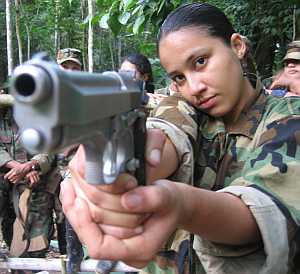 Not to be confused with the (rather tedious, IMHO) bunch of New York feminist artists, this is about Isabel, the well-educated daughter of a middle-class family, who opts to toss it all away and go into the jungles of Colombia to fight the revolution with FARC, the insurgents who have been rebelling against the government for more than 40 years. She undergoes training, both political and military, and has to adapt to an environment radically different from the one she knew before. It’s not always successful, and you wonder how she’s ever going to become a “freedom fighter” when she can’t even take part in the slaughter of a cow. [shown, below right – PETA activists will
Not to be confused with the (rather tedious, IMHO) bunch of New York feminist artists, this is about Isabel, the well-educated daughter of a middle-class family, who opts to toss it all away and go into the jungles of Colombia to fight the revolution with FARC, the insurgents who have been rebelling against the government for more than 40 years. She undergoes training, both political and military, and has to adapt to an environment radically different from the one she knew before. It’s not always successful, and you wonder how she’s ever going to become a “freedom fighter” when she can’t even take part in the slaughter of a cow. [shown, below right – PETA activists will  e the film-makers didn’t want to go down that avenue, and since they were out in the jungle, with a group of heavily-armed insurgents, I can hardly blame them for letting that angle slide. Instead, it lets the film speak for itself, and FARC does sometimes come across as little better than kids playing soldiers: one, particularly memorable part of the training, consists of recruits running around, waving wooden guns about and shouting “BANG!” at imaginary opponents. They also have a startlingly bad ‘national anthem’, which sounds more like the fight song from a third-rate community college.
e the film-makers didn’t want to go down that avenue, and since they were out in the jungle, with a group of heavily-armed insurgents, I can hardly blame them for letting that angle slide. Instead, it lets the film speak for itself, and FARC does sometimes come across as little better than kids playing soldiers: one, particularly memorable part of the training, consists of recruits running around, waving wooden guns about and shouting “BANG!” at imaginary opponents. They also have a startlingly bad ‘national anthem’, which sounds more like the fight song from a third-rate community college. Nita Daniels (Wagner) and her three girlfriends take a horseback trip up the mountain, expecting to meet their husbands at the top. However, the trip becomes a nightmare, as four members of the ‘Aryan Survivalist Brigade’ are holed up there, and decide to take out the women and their alcoholic guide, Ding (Skerritt). Initially, Ding takes the fore, but when he is injured it’s up to Nita and her pals to fight back. This TVM struggles, largely because of the lack of justification for the white supremacists: the entire party they attack are about as Aryan as they come, so why, exactly, should they be targeted for elimination? It would have been far more plausible had the party been ethnically-mixed, or even their guide been black – or, heck, Jewish.
Nita Daniels (Wagner) and her three girlfriends take a horseback trip up the mountain, expecting to meet their husbands at the top. However, the trip becomes a nightmare, as four members of the ‘Aryan Survivalist Brigade’ are holed up there, and decide to take out the women and their alcoholic guide, Ding (Skerritt). Initially, Ding takes the fore, but when he is injured it’s up to Nita and her pals to fight back. This TVM struggles, largely because of the lack of justification for the white supremacists: the entire party they attack are about as Aryan as they come, so why, exactly, should they be targeted for elimination? It would have been far more plausible had the party been ethnically-mixed, or even their guide been black – or, heck, Jewish. ★★★
★★★ Has it really been three years since the last installment? Guess so. Therefore, about time for the most durable of the video-game to movie franchises, to pop up with another entry. Things continue to go from bad to worse as far as Planet Earth is concerned, with the T-virus, which spread from the complex to Raccoon City last time, now infecting the entire world. A few survivors roam the wastelands, such as in a convoy led by Claire Redfield (Larter), unable to stay in one place too long, because the zombies will locate them. Meanwhile, Dr. Isaacs (Glen) is working on reversing the virus, or at least making the zombies docile – though his approach to scientific teamwork leaves a little to be desired, shall we say. He also has a pit where he disposes of his raw material, an aspect that reminded me of the original Aeon Flux short films.
Has it really been three years since the last installment? Guess so. Therefore, about time for the most durable of the video-game to movie franchises, to pop up with another entry. Things continue to go from bad to worse as far as Planet Earth is concerned, with the T-virus, which spread from the complex to Raccoon City last time, now infecting the entire world. A few survivors roam the wastelands, such as in a convoy led by Claire Redfield (Larter), unable to stay in one place too long, because the zombies will locate them. Meanwhile, Dr. Isaacs (Glen) is working on reversing the virus, or at least making the zombies docile – though his approach to scientific teamwork leaves a little to be desired, shall we say. He also has a pit where he disposes of his raw material, an aspect that reminded me of the original Aeon Flux short films. The main problem, I feel, is that giving Alice mental powers detracts from the physical side of action, which has always been a major part of this series’s appeal: watching Jovovich kick zombie butt. The Las Vegas battle is unquestionably the highlight of the film as far as that goes, with Alice adopting a no-nonsense, slice-and-dice approach, that’s a gleeful joy to watch. After it, however, things go somewhat wonky: the entire Redfield subplot is airily waved away, and then there’s the inevitable boss level fight – this time against the Tyrant [if you’ve played the games, you probably know what that is, which puts you one-up on me], a somewhat rubbery, tenticular beast that is not among Patrick Tatopoulos’s best work.
The main problem, I feel, is that giving Alice mental powers detracts from the physical side of action, which has always been a major part of this series’s appeal: watching Jovovich kick zombie butt. The Las Vegas battle is unquestionably the highlight of the film as far as that goes, with Alice adopting a no-nonsense, slice-and-dice approach, that’s a gleeful joy to watch. After it, however, things go somewhat wonky: the entire Redfield subplot is airily waved away, and then there’s the inevitable boss level fight – this time against the Tyrant [if you’ve played the games, you probably know what that is, which puts you one-up on me], a somewhat rubbery, tenticular beast that is not among Patrick Tatopoulos’s best work. Things do perk up at the very end. As in the first two films, there’s a grand final shot, which leaves you eagerly anticipating the next part – in this case, presumably called Resident Evil: Globapocarnarmagediediedie. Certainly, I wouldn’t be
Things do perk up at the very end. As in the first two films, there’s a grand final shot, which leaves you eagerly anticipating the next part – in this case, presumably called Resident Evil: Globapocarnarmagediediedie. Certainly, I wouldn’t be 










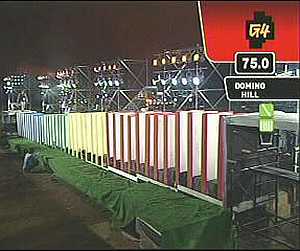 With somewhere north of two hundred cable channels to surf through, a show has about ten seconds to grab our attention. When we spotted Ninja Warrior on G4 Tech TV, I thought it would probably be one of those anime series. I couldn’t be more wrong. It’s actually a sports entertainment series from Japan, where competitors go through four assault-course type stages, of increasing toughness. It’s pretty brutal; in the decade the show has been on the air, only two of the 1,800 entrants have made it all the way to the end. However, it’s presence here is due to the spin-off for female competitors, which is being broadcast, also on G4, as Women of Ninja Warrior; the Japanese title Kunoichi translates, more or less, as “female ninja.”
With somewhere north of two hundred cable channels to surf through, a show has about ten seconds to grab our attention. When we spotted Ninja Warrior on G4 Tech TV, I thought it would probably be one of those anime series. I couldn’t be more wrong. It’s actually a sports entertainment series from Japan, where competitors go through four assault-course type stages, of increasing toughness. It’s pretty brutal; in the decade the show has been on the air, only two of the 1,800 entrants have made it all the way to the end. However, it’s presence here is due to the spin-off for female competitors, which is being broadcast, also on G4, as Women of Ninja Warrior; the Japanese title Kunoichi translates, more or less, as “female ninja.”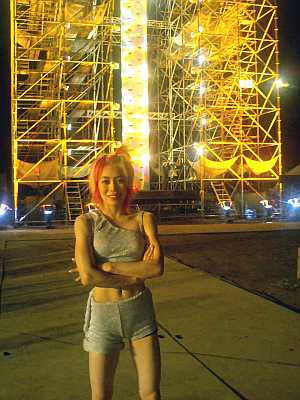 The tests here, however, are aimed more at agility than strength, such as Domino Hill (top, right) a precarious test of balance on increasingly-unstable block. They certainly remain extremely challenging: the first tournament was so brutal, that only two competitors made it past stage one, and neither survived the first obstacle on stage two. Only one woman has ever completed the course, the “Queen of Ninja Warrior”, G-Rockets dancer Ayako Miyake, and she has done it an incredible three times, despite adjustments made after each tournament. That’s hasn’t stopped Miyake, who has whizzed up the final stage (bottom, left) without apparent problem, netting her the grand prize of two million yen (about $20,000) per show, and making the tiny (5’2″, 90-pound!) dancer something of a celebrity. She’d be great as Kei if they ever did a live-action version of Dirty Pair Flash.
The tests here, however, are aimed more at agility than strength, such as Domino Hill (top, right) a precarious test of balance on increasingly-unstable block. They certainly remain extremely challenging: the first tournament was so brutal, that only two competitors made it past stage one, and neither survived the first obstacle on stage two. Only one woman has ever completed the course, the “Queen of Ninja Warrior”, G-Rockets dancer Ayako Miyake, and she has done it an incredible three times, despite adjustments made after each tournament. That’s hasn’t stopped Miyake, who has whizzed up the final stage (bottom, left) without apparent problem, netting her the grand prize of two million yen (about $20,000) per show, and making the tiny (5’2″, 90-pound!) dancer something of a celebrity. She’d be great as Kei if they ever did a live-action version of Dirty Pair Flash.